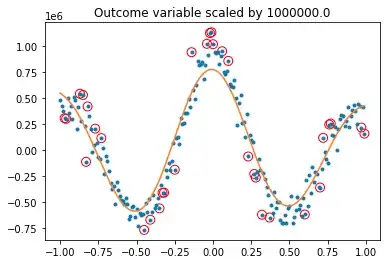Should I scale outcome variable for SVM regression? What is the magnitude of impact of outcome variable scaling in SVM regression?
-
cross-posted at https://datascience.stackexchange.com/q/89673/55122 – Ben Reiniger Feb 21 '21 at 04:10
1 Answers
In support vector regression (with linear loss), we minimise the objective function:
\begin{align} \min_{\mathbf{w}, b, \mathbf{\xi}} \quad & \frac{1}{2}\| \mathbf{w}\|^2 + C\sum_i \mathbf{\xi}_i + \mathbf{\hat \xi}_i \\ \text{s.t.} \quad & (\mathbf{w} \cdot \mathbf{x}_i + b) - y_i \leq \varepsilon + \xi_i \\ \quad & y_i - (\mathbf{w} \cdot \mathbf{x}_i + b) \leq \varepsilon + \hat \xi_i \\ \quad & \xi_i, \hat \xi_i \geq 0 \end{align}
As you can see from the conditions, $\varepsilon$ and the slack variables $\xi_i, \hat \xi_i$ are on the same scale as the output variables $y_i$. So, as you scale $y$, you need to scale $\varepsilon$. On the other hand, in the objective function, $\mathbf{w}$ enters quadratically, and the slack variables only linearly. To keep the balance unchanged, you also need to scale the multiplicative factor $C$.
Assuming you've adjusted the hyperparameters accordingly, the scaling has no effect:
import numpy as np
import matplotlib.pyplot as plt
from sklearn import svm
def svmTest(x, y1, sc=1):
N = x.shape[0]
x = x.reshape([-1, 1])
regr = svm.SVR(C=sc*N/100, epsilon=sc*.2)
y2 = sc*y1
regr.fit(x, y2)
y2p = regr.predict(x)
plt.plot(x, y2, '.', )
plt.scatter(x[regr.support_], y2[regr.support_], s=80, facecolors='none', edgecolors='r')
plt.plot(x, y2p, '-')
plt.gca().set_title(f'Outcome variable scaled by {sc}')
x = np.arange(-1, 1, .01)
y = np.cos(2*np.pi*x)*np.exp(-np.abs(x)) + np.random.normal(0, .1, x.shape[0])
x = x.reshape([-1, 1])
svmTest(x, y, 1) produces:
while svmTest(x, y, 1e6) produces:
- 6,004
- 1
- 16
- 41

